Whale Watching Big Island: Ultimate Guide & Tours
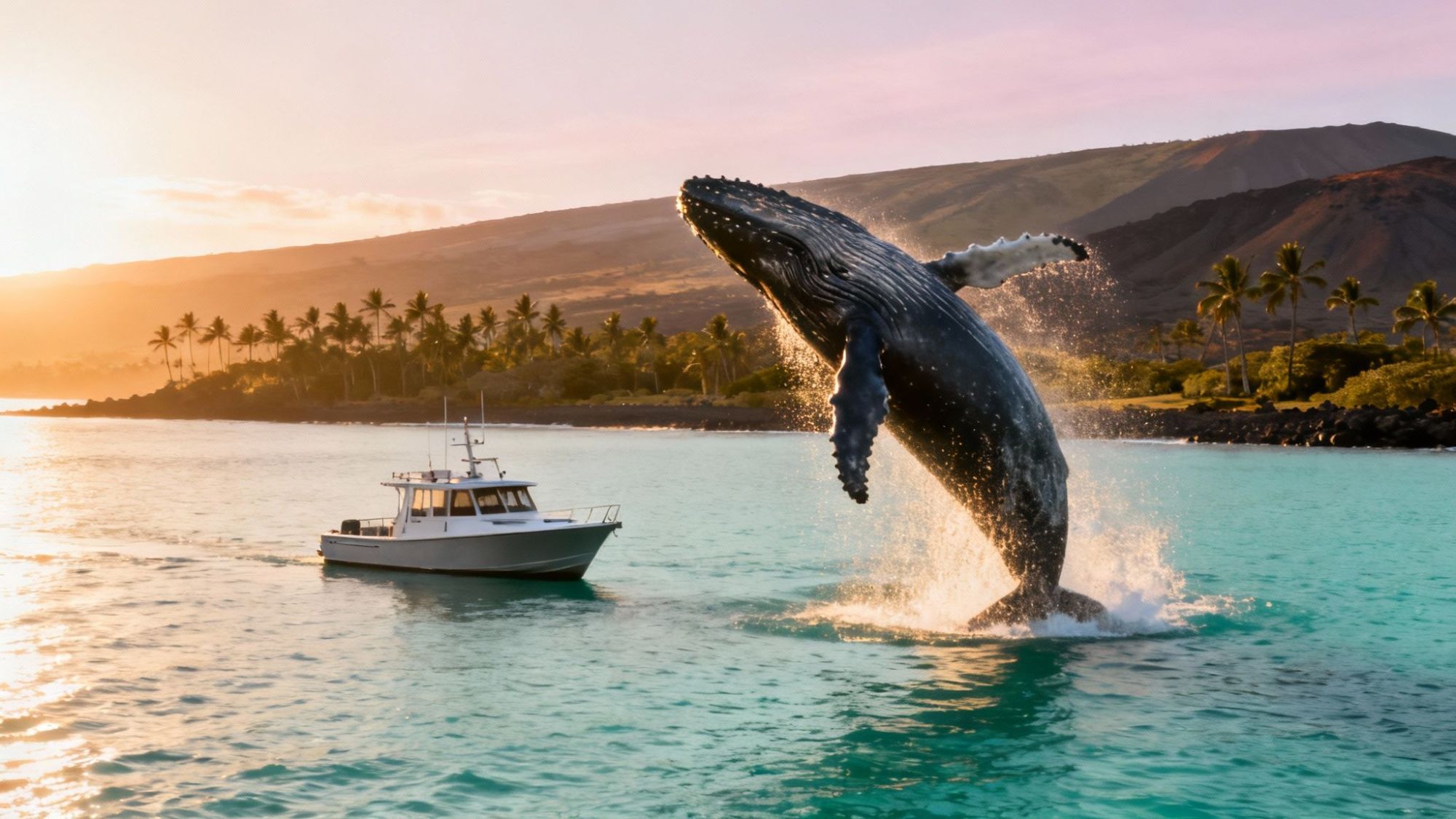
The absolute best time for whale watching on the Big Island falls during their annual migration, which runs from November through April. If you really want to hit the jackpot, plan your trip for the peak months of January to March. This is when the calm, protected waters along the Kona and Kohala coasts become the world's most spectacular humpback whale nursery.
As the top-rated and most-reviewed snorkel company in Hawaii, Kona Snorkel Trips is your expert guide to these magnificent creatures.
Why the Big Island Offers Unforgettable Whale Encounters
Have you ever tried to imagine the raw power of a 40-ton humpback whale launching its entire body out of the water? It’s a sight that will stick with you forever—the explosion of whitewater, the thunderous crash, all set against the dramatic backdrop of the Big Island’s volcanic coastline. This is what makes it a top-tier global destination for anyone who loves whales.
Each year, thousands of North Pacific humpback whales make an epic 3,000-mile journey from their frigid feeding grounds in Alaska down to Hawaii's warm, welcoming waters.
This isn't just a tropical vacation for them; it's a crucial part of their life cycle. The ocean surrounding the Big Island is a vital sanctuary where these magnificent creatures come to breed, give birth, and nurse their newborn calves in a safe, protected environment.
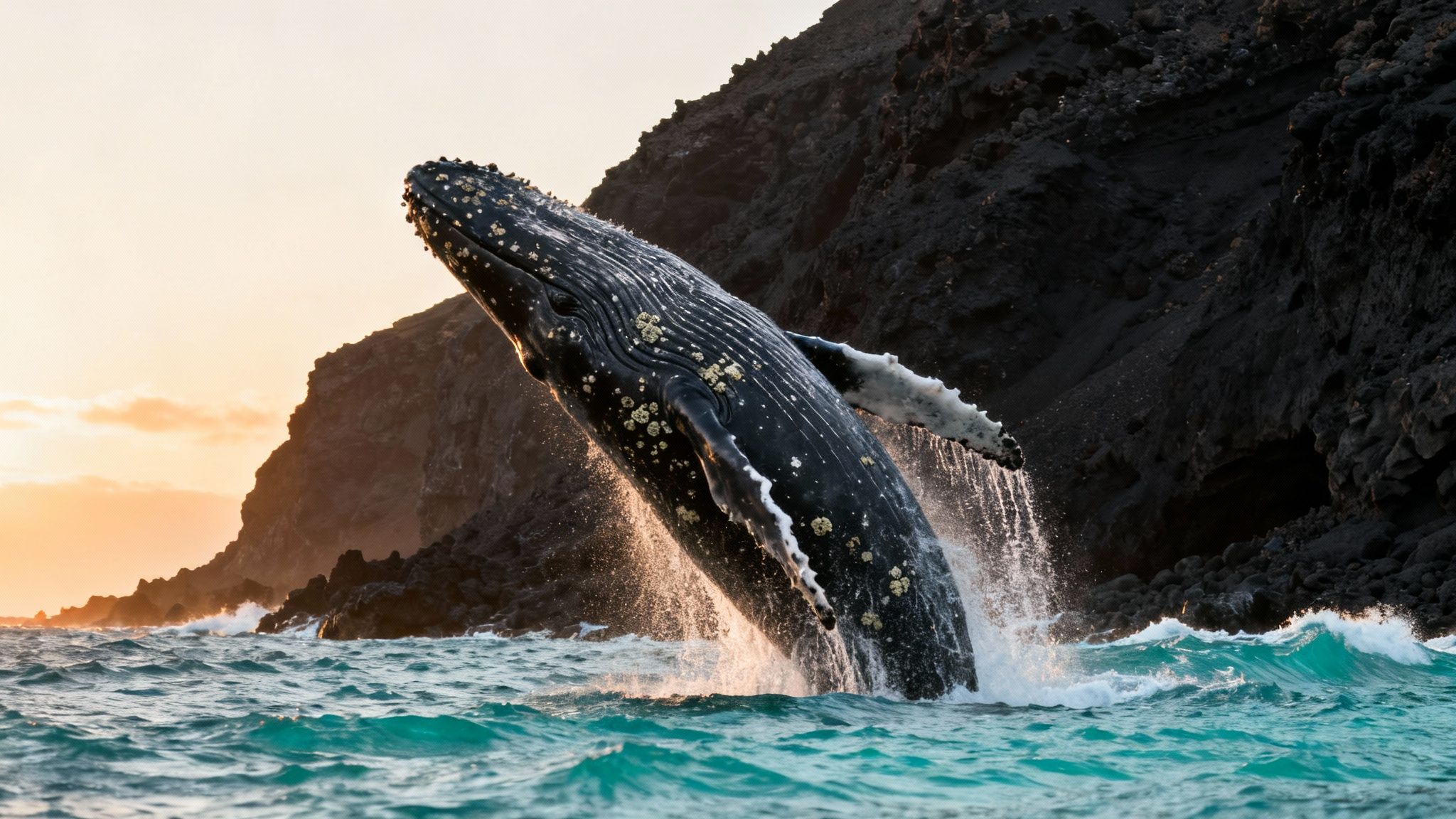
A Unique Underwater Haven
So, what makes the Big Island so special for the whales? It comes down to the island’s massive volcanoes, Mauna Kea and Mauna Loa. They create a huge "wind shadow" that shields the western Kona and Kohala coasts from the powerful trade winds, resulting in exceptionally calm and clear seas.
These sheltered waters are perfect for mother whales and their vulnerable calves. The shallow coastal areas also offer a safe haven from deep-water predators, giving the calves the time they need to grow stronger before tackling the long, arduous swim back north to Alaska.
This unique combo of geography and calm seas transforms the leeward coast into a bustling humpback nursery. To really nail down the timing for your trip, you can dive deeper into the whale season on the Big Island in our detailed guide.
Your Expert Guide to the Ocean
Putting together the perfect whale watching adventure is all about having good local knowledge. Throughout this guide, we'll be sharing insights from our team here at Kona Snorkel Trips, Hawaii's top-rated and most-reviewed snorkel and tour company.
Our lifeguard-certified crew lives and breathes this stuff. We understand the nuances of our local marine life and are dedicated to creating safe, respectful, and truly unforgettable encounters with these gentle giants.
With a deep commitment to conservation and a focus on small-group tours, we make sure every guest leaves with a profound appreciation for the ocean while enjoying a personalized adventure. Choosing the right operator is the first, and most important, step to an experience you'll never forget.
The Incredible Journey of Hawaii's Humpback Whales
That unbelievable moment when a 40-ton humpback whale launches its entire body out of the water is more than just a photo op—it's the grand finale of a truly epic story. Every single whale you'll see while whale watching on the Big Island is a world-class traveler, having just completed a grueling journey of over 3,000 miles across the open Pacific.
This yearly pilgrimage is one of the longest migrations of any mammal on the planet. Every fall, thousands of North Pacific humpbacks leave their chilly, food-rich feeding grounds up in Alaska and point themselves south. Their destination? The warm, sheltered, and surprisingly shallow waters that hug the Hawaiian Islands.
But this is no vacation. This marathon swim is absolutely critical for the survival of their species. The whales don't eat for their entire stay in Hawaii, living off the massive fat reserves they packed on during their summer feast. All of their energy goes into the two most important jobs they have: breeding and giving birth.
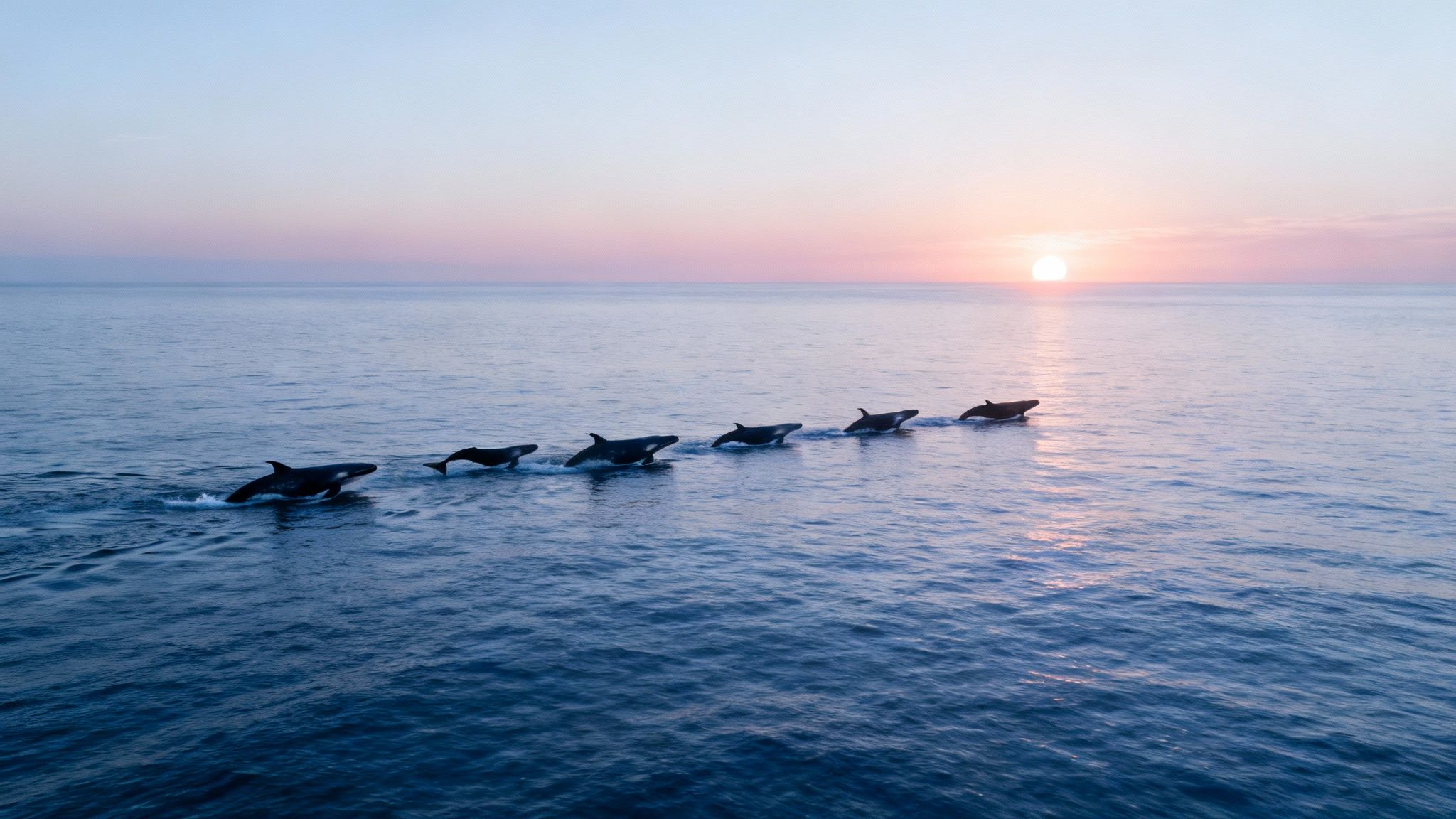
A Nursery in Paradise
The waters just off the Big Island's Kona and Kohala coasts are basically a giant, natural nursery. The calm, warm environment is perfect for pregnant females to deliver their calves, which arrive weighing about a ton and measuring up to 15 feet long. Talk about a big baby.
These protected waters give the newborns a safe space to learn the ropes of being a whale. They'll spend their days nursing on their mother's milk, which is unbelievably rich—we're talking 40-60% fat content! This allows them to pack on up to 100 pounds per day. That rapid growth is vital for building the strength and blubber they'll need for their very first trip back north to Alaska.
For us lucky observers on the boat, this time of year offers a front-row seat to some of the most incredible behaviors:
- Mothers and Calves: There's nothing quite like watching a massive mother whale gently nudge her calf to the surface to breathe, patiently teaching it how to swim.
- Competitive Pods: Things can get rowdy! You might see a group of males, known as a competitive pod, chasing a single female, leading to some powerful and acrobatic surface action.
- Breaching and Tail Slapping: These are the showstoppers. Whether it's a form of communication or a raw display of power, seeing a whale breach or slap its massive tail on the water is something you'll never forget.
Knowing what's really going on turns a simple sightseeing trip into a deep appreciation for what these amazing animals go through just to survive.
A Conservation Comeback Story
It's almost impossible to believe now, but the thriving whale population we enjoy today was once pushed to the very edge of oblivion. Unchecked commercial whaling in the 20th century absolutely devastated the North Pacific humpback population, bringing them terrifyingly close to extinction.
The turnaround is one of the greatest success stories in marine conservation. Thanks to international protection and incredible local dedication, the population has made a comeback that can only be described as remarkable.
The Pacific humpback whale population has bounced back from near-extinction in the 1960s to an estimated 26,000 individuals today, with a huge number of them migrating to Hawaii each winter. This recovery is deeply tied to the protections offered by the Hawaiian Islands Humpback Whale National Marine Sanctuary. You can learn more about this amazing conservation effort and its impact on the whales.
This sanctuary, created in the early 1990s, gives these whales a safe harbor to breed, birth, and raise their young without being disturbed. Responsible tour operators are a huge part of this ongoing effort, sticking to strict guidelines and teaching visitors why it's so important to give these magnificent creatures their space.
Every whale watching tour isn't just a chance to see whales; it’s a celebration of their incredible resilience and a powerful reminder of our job to protect them for generations to come.
When to Go for the Best Whale Sightings
Timing your trip right is the single most important factor for an unforgettable whale watch on the Big Island. Humpback whales grace our waters for a solid chunk of the year, but knowing when to book can be the difference between a few distant spouts and a full-on acrobatic show.
Think of the season as a wave building. It starts small in late fall, swells to an unbelievable peak in the dead of winter, and then gently recedes as spring takes hold. Understanding this natural rhythm is your ticket to being in the right place at the right time.
The official whale season runs from November through April, but the experience changes dramatically from month to month. A trip in December feels completely different than one in February, and each part of the season has its own unique magic.
Big Island Whale Watching Season at a Glance
To really nail down your travel dates, it helps to see how the season unfolds. This table gives you a quick snapshot of what to expect, helping you match your trip to the kind of whale action you're hoping to see.
| Month | Whale Activity Level | Common Behaviors to Observe |
|---|---|---|
| November – December | Low to Moderate | The first arrivals appear. You'll see initial spouts, flukes, and maybe a few early breaches as they settle in. |
| January | High | Numbers increase dramatically. Competition pods form, leading to more surface action and pectoral fin slapping. |
| February | Peak | The highest concentration of whales. Breaching, tail slapping, and spy-hopping are all common. Calving season is in full swing. |
| March | High | Still fantastic viewing. Lots of mother-and-calf pairs are visible, often staying close to the surface. |
| April | Moderate to Low | The last whales, mostly mothers with their newborns, begin their journey north. Sightings become less frequent. |
For a deeper dive into the whole migration, check out our complete guide to the Hawaii whale season. It's packed with even more detail on what makes this time so special.
Why January to March Is the Sweet Spot
If you want the full, jaw-dropping experience, January through March is your window. This is when the party is in full swing. The waters off the Kona and Kohala coasts are absolutely teeming with whales, and you get to see their entire social playbook unfold.
You're almost certain to witness competitive pods—groups of powerful males chasing a single female in a stunning display of strength and agility. This is also when most calves are born, so seeing a mother gently nudging her newborn to the surface for its first breath is an incredibly common, and truly moving, sight.
During the peak months of January and February, dedicated whale counts have recorded an average of 3 to 6 whales every 15 minutes in prime locations along the Kohala coast. That kind of density means every trip is an action-packed adventure.
Choosing the Best Time of Day for Your Tour
Once you've zeroed in on the right month, the next step is picking your tour time. While you can see whales all day, I always tell people to book a morning trip if they can.
It really comes down to the weather. The seas along the Kona coast are typically like glass in the morning before the afternoon trade winds kick up. A calm surface makes it so much easier to spot a distant spout, fluke, or breach.
Plus, the lower sun angle means less glare on the water and better light for photos. Data shows that the number of whale sightings at 8:00 a.m. can be up to 50% higher than those at midday. An early start is definitely worth it.
Finding the Best Whale Watching Hotspots
If you're looking for whales on the Big Island, you have to know where to look. While you might get lucky and spot a distant spout from just about anywhere, not all coastlines are created equal. The real action—the highest concentration of humpback whales—consistently happens along the island's western shores.
The legendary Kona and Kohala coasts are where it’s at. And that's no accident; it’s all thanks to the island’s incredible geography.
Think of the two massive volcanoes, Mauna Kea and Mauna Loa, as gigantic natural shields. They create a "wind shadow," protecting the leeward (west) side of the island from the powerful north-easterly trade winds that batter the rest of the island.
The result? A stretch of ocean that is remarkably calm, clear, and protected. It’s the perfect, safe nursery for humpback whales, and it's exactly what pregnant females and mothers with newborn calves are searching for.
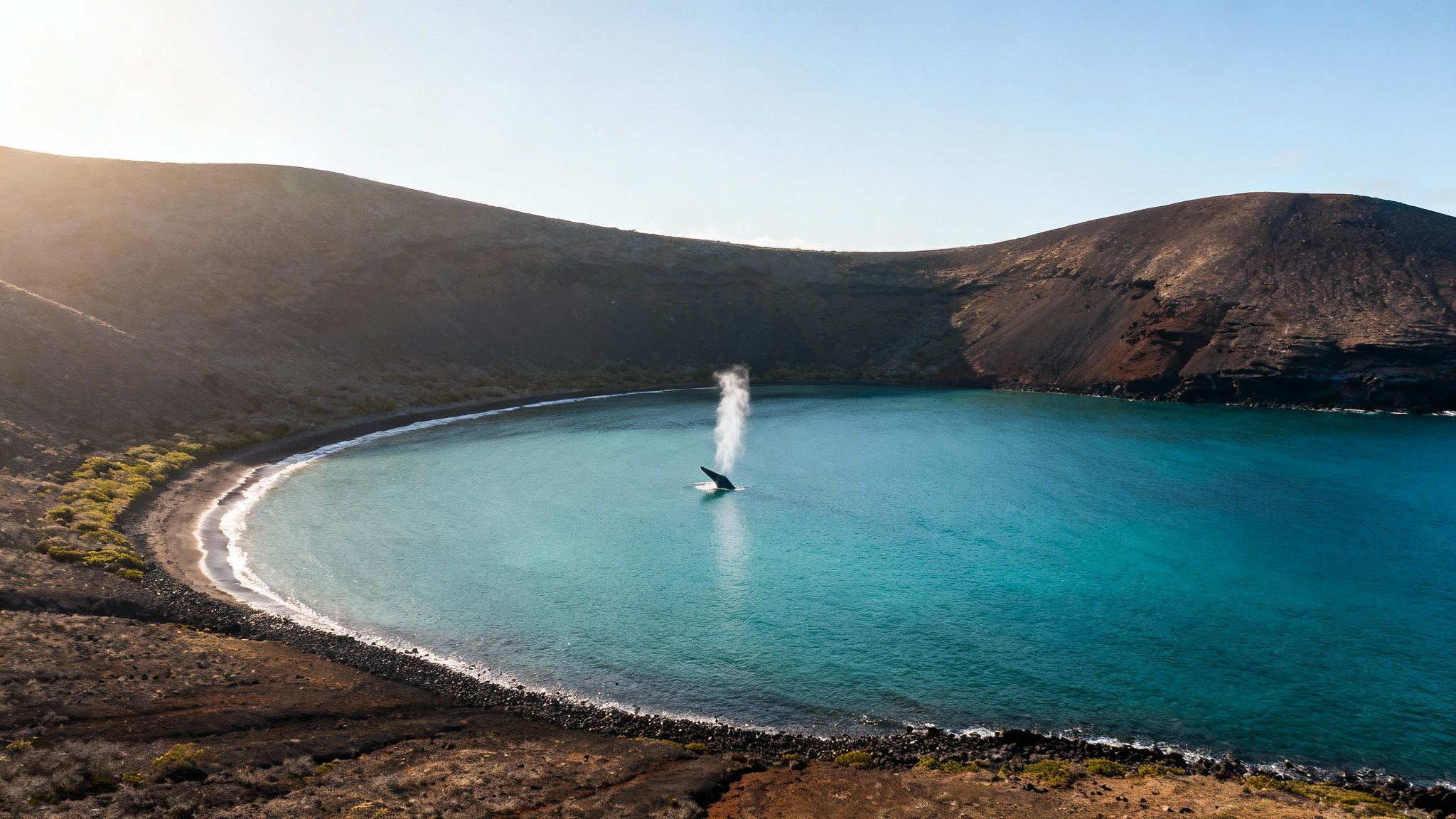
Why the Kohala Coast Is a Whale Magnet
The Kohala Coast, in particular, has earned its reputation as the epicenter of whale activity. Its shallow, sandy-bottomed waters, often less than 600 feet deep, create an ideal safe zone for mothers to rest and nurse their young without the threat of deep-water predators.
Because of this unique setup, people often call the Kohala Coast the "whale nursery" of Hawaii. Time and again, observations show this area has two to three times more whale sightings than other parts of the island. It’s all about those calm waters sheltered by the volcanoes. If you want to dive deeper into the science, you can explore more details about Big Island's whale watching conditions.
For you, this concentration means a much higher chance of witnessing spectacular behaviors like breaching, tail slapping, and those tender moments between a mother and her calf.
Shore Viewing Versus Boat Tours
So, how do you want to see them? You've got two main options: watching from shore or hopping on a boat tour. Each offers a totally different vibe, and the best choice really comes down to your budget, time, and what kind of experience you're hoping for.
Shore-Based Whale Watching
Spotting whales from land is a fantastic, free way to go if you've got some patience and a good pair of binoculars. Several scenic lookouts along the Kohala Coast offer killer vantage points.
- Puukohola Heiau National Historic Site: The name literally means "hill of the whale," so you know you're in the right place. Its elevated position gives you a panoramic view of the ocean.
- Lapakahi State Historical Park: This spot offers another great perch over the calm coastal waters where whales frequently cruise by.
- Kapaa Park: A popular spot with locals, this park is a great place to post up, relax, and scan the horizon for spouts.
The biggest pro is the cost—it's free! The downside, however, is distance. You'll be watching from afar, so a massive breach might look more like a small splash on the horizon.
Boat-Based Whale Watching
For a truly immersive experience, nothing beats a boat tour. Getting out on the water puts you right there with these incredible animals (while maintaining a respectful and legal distance, of course).
A boat tour transforms whale watching from a passive observation into an active adventure. You're not just looking at the ocean; you're part of it. The ability to hear a whale's breath or listen to its song through a hydrophone is an experience you simply can't get from shore.
Boat tours have some huge advantages:
- Closer Views: Even while staying the required 100 yards away, you're so much closer to the action. It gives you a true sense of their massive scale and makes for incredible photo ops.
- Expert Guidance: A good captain and naturalist can spot whales you'd definitely miss and share fascinating insights into what you're seeing.
- Mobility: If things are quiet in one spot, a boat can simply move to another hotspot, which dramatically increases your chances of a great sighting.
While shore viewing is a wonderful way to spend an afternoon, a well-chosen boat tour is what gets you to the heart of the action for a more dynamic, educational, and downright awe-inspiring encounter.
How to Choose the Right Whale Watching Tour
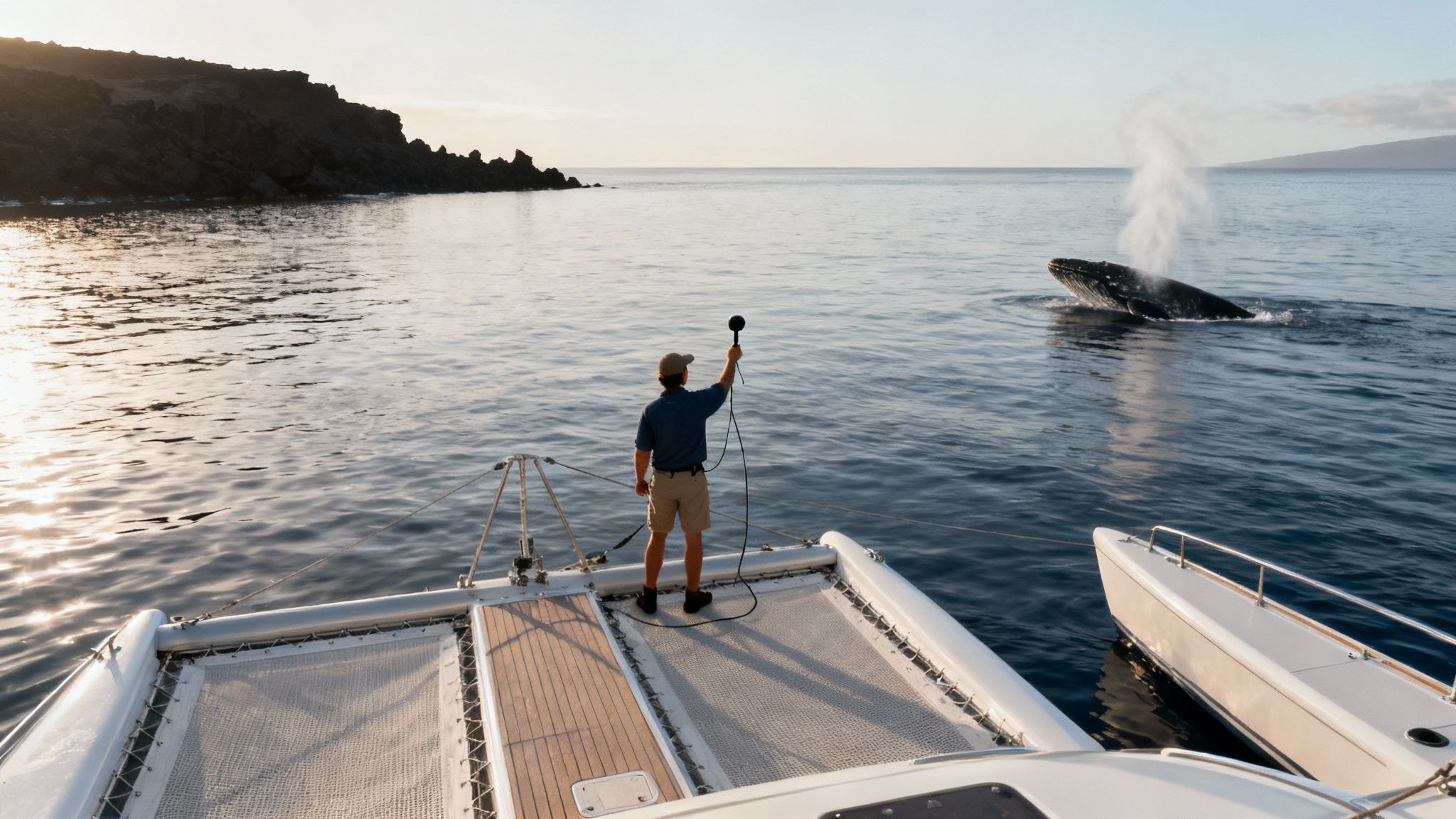
Picking the right tour operator can make or break your whale watching Big Island adventure. With so many boats heading out each day, knowing what to look for is the key to having a safe, respectful, and genuinely mind-blowing experience. Your choice really boils down to two things: the kind of boat you're on and the philosophy of the people running it.
The first decision is all about the vessel. Are you picturing a big, stable catamaran or a smaller, more intimate raft? They offer completely different vibes.
- Large Catamarans: These are a fantastic bet for families or anyone a bit worried about seasickness. Their stability makes for a smooth ride, and they usually have creature comforts like restrooms and shaded seating.
- Zodiac-Style Rafts: If you’re looking for a thrill, these smaller, faster boats put you right at water level for an up-close-and-personal perspective. You feel every wave and get much closer to the action, making for an unforgettable encounter.
But beyond the boat itself, it’s the crew's expertise and the company’s respect for the whales that really sets a tour apart.
What Makes a Great Tour Operator
A great whale watching tour is so much more than just a boat ride—it’s an education. When you’re looking at your options, zero in on operators who care as much about the whales as they do about their guests. A solid company like Kona Snorkel Trips is known for its experienced, lifeguard-certified crews and a focus on small-group tours, which creates a far more personal and meaningful connection with the animals.
One of the biggest game-changers is having an expert naturalist on board. They can read the whale's behavior, drop fascinating facts, and answer all your questions, turning a simple sighting into a real learning moment. Another incredible tool to look for is a hydrophone. Hearing the complex, haunting songs of the humpback whales through this underwater microphone is something you will never, ever forget.
Data from the Sanctuary Ocean Count, a citizen science project running since 1996, consistently shows the Kohala coast is the premier spot for sightings, with observers often spotting 3 to 6 whales every 15 minutes during peak season. You can explore over 20 years of fascinating sighting data to see why this area is so active. Learn more about these valuable whale population insights.
A Checklist for Choosing Your Tour
To make things simple, here’s a quick checklist of what to look for in a quality operator. If the company you're considering ticks these boxes, you're on the right track.
- Experienced Captain and Crew: Look for companies with a long history and great reviews that specifically mention the crew's knowledge and professionalism.
- Small Group Sizes: Fewer people means a better view for everyone, no jostling for space at the rail, and more one-on-one time with the guides.
- Educational Component: Do they have a naturalist? Do they use a hydrophone? A tour that teaches you something is always more memorable.
- Commitment to Eco-Friendly Practices: Responsible operators stick to the federal viewing guidelines like glue (staying 100 yards away) and actively promote conservation.
- Safety First: Check that the company has a strong safety record and provides clear instructions and all the necessary gear.
When you're making your final choice, consider operators that are committed to sustainable travel practices that help protect Hawaii's incredible marine life. By weighing these factors, you'll find a tour that not only leaves you with amazing memories but also supports the well-being of these magnificent animals. You can also dive deeper into our breakdown of the different whale watching tours in Kona to find your perfect match.
Got Questions? We've Got Answers.
To make sure you're all set for the big day, we've put together answers to the questions we hear most often about whale watching on the Big Island. Think of this as your cheat sheet for planning an absolutely incredible day out on the water.
What Should I Bring on a Whale Watching Tour?
Packing smart is the key to a comfortable trip. You're heading out on the ocean, so think of it like a beach day, just with a bit more breeze and potential for sea spray.
Definitely bring along reef-safe sunscreen, a good hat, and polarized sunglasses—they work wonders for cutting the glare on the water. It can get surprisingly chilly once the boat gets moving, so a light jacket or windbreaker is always a good call.
You'll want binoculars for those up-close views! And if you're hoping to snag that perfect photo of a whale breaching, a camera with a decent zoom lens is a must. One last tip: if you're prone to motion sickness, it's a good idea to take your go-to remedy before we even leave the harbor.
Are Whale Sightings Guaranteed?
This is probably the number one question we get, and the honest answer is: no, they can't be 100% guaranteed. These are wild animals roaming a vast ocean, and that unpredictability is exactly what makes every single sighting so special.
That said, your chances during peak season—from January through March—are fantastic. Experienced captains, like ours at Kona Snorkel Trips, are out on these waters daily and have an instinct for whale behavior. They know the spots the whales love and have a nearly perfect track record for finding them.
In fact, many of the best tour operators are so confident they'll give you a voucher to come back for free if you don't see any whales on your trip.
How Close Can We Get to the Whales?
Giving the whales their space is our top priority, and it's also the law. Federal regulations are crystal clear: all boats have to stay at least 100 yards (or 300 feet) away from humpback whales. This is non-negotiable, especially for moms with their newborn calves, as it ensures we don't disturb their natural behavior.
But don't think for a second that this distance takes away from the experience. A 45-foot-long, 40-ton animal launching itself out of the water is an unforgettable sight, even from a football field away. You truly grasp their immense size and power.
The real magic happens when a whale gets curious and decides to check us out. We call these "muggings," and they are some of the most profound, humbling moments you can have on the water. When a whale chooses to approach, it's entirely on their terms.
Any responsible captain will cut the engines when whales are near, letting the animals call the shots and control the entire encounter.
What Other Marine Life Might We See?
The humpbacks are the headliners, no doubt about it, but your tour is a front-row seat to the Big Island's entire marine ecosystem. The ocean here is buzzing with life.
It's pretty common to run into massive pods of spinner dolphins, famous for their incredible acrobatic displays. We also frequently see bottlenose dolphins surfing our bow wave or the occasional Hawaiian green sea turtle (honu) popping its head up for a breath.
You never know what the ocean will serve up! We've seen:
- Spinner Dolphins: Their energy is infectious, and seeing a pod of hundreds is pure joy.
- Bottlenose Dolphins: Bigger and often more inquisitive than their spinner cousins.
- Hawaiian Green Sea Turtles (Honu): A sacred animal here, and spotting one always feels like a gift.
- Pilot Whales: Smaller toothed whales that travel in tight-knit family groups.
- Manta Rays: On a lucky day, you might see the wingtips of a majestic manta gliding by.
Every trip is different. One day it's pilot whales, the next it might be a rare glimpse of a manta ray. Your whale watching Big Island adventure is really a full-blown wildlife safari on the water.
Ready for an unforgettable adventure? Join Kona Snorkel Trips for a small-group whale watching experience that's both personal and respectful. Our expert, lifeguard-certified guides can't wait to share the magic of these gentle giants with you.
